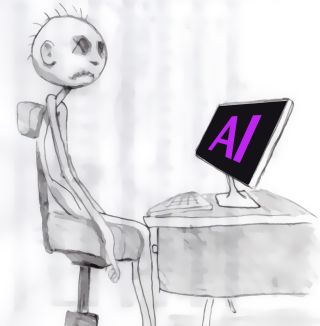Artificial Intelligence
Artificial Intelligence Is Higher Ed's Pandora’s Box
Community colleges will reach the leading edge in education in adopting AI.
Posted August 23, 2023 Reviewed by Hara Estroff Marano
Key points
- Artificial intelligence will change the role of students, faculty, administration, and governance.
- On the whole, the future of AI in higher education is positive.
- Twenty-five years ago AI was seen as a niche technical area in higher education.
- Maintaining the human dimension is part of the challenge in the acceptance of AI.
On July 10, 2023, the Chief Information Systems Officer Association (CISOA.org) met for its annual conference aboard the Queen Mary in Long Beach, California. CISOA members include the technology chiefs from all 116 California community colleges, annually serving more than two million students.Among the millions of graduates are the majority of California’s police, firefighters, nurses, and emergency medical technicians (EMTs). (CCC Keyfacts)

The community college technology chiefs identified the promise and danger of artificial intelligence as the theme of their advanced seminar and number one among their present interests. Specifically, they focused on the impact and potential of AI in education and learning.
The overall conclusion of the CISOs was that AI is a net positive for education and learning. While the chiefs are optimistic and agreed that AI is a net positive in education, it is also acknowledged as representing a double-edged sword. There are negatives to be managed. There is little question that AI will speed up information search and enhance the prediction of trends. The potential of AI and language structure-driven search will also revolutionize today’s traditional research methods and have a great influence on predictions and decision-making. AI will also affect many jobs and significantly refine and enhance administrative and student services.

The chiefs also agreed that the COVID pandemic significantly accelerated embrace of hybrid, online, and distance learning. However, one of the biggest concerns about AI applied in education is that it can also dehumanize the learning experience. Maintaining a human connection is critical. With AI algorithms generating content and managing the pace of learning experiences, it is important to preserve the nuanced approach that a human teacher and support staff member can offer. In addition, the trend toward diminishing the human response by substituting the chatbot response with verbal, email, and text communication was noted as a critical factor that requires continuous attention, research, and evaluation.
The general consensus included advancing AI in ways that:
- Support personalized learning in ways that were previously impossible.
- Provide learners with immediate feedback that optimizes effective learning.
- Provide learners with access to vast amounts of information that they may not otherwise have had access to.
- Help to reduce the workload of teachers and administrators.
- Facilitate smoother governance throughout cooperating partners.
ChatGPT, for example, can be a helpful tool in supplementing learning, but it is crucial to remember its limitations and the need for human interaction.
Educators need to be mindful of the benefits and limitations of AI and use it appropriately. Learners need to develop skills to navigate AI-based learning tools effectively. AI has the potential to help positively transform education, but it must be used ethically, transparently, and with consideration by learners and educators alike.
ChatGPT is just one example of the increasing number of AI tools rapidly becoming available, as the new AI boom replicates the dot.com boom period—but, hopefully, not the dot.com bust that occurred at the end of the twentieth century. Therefore, when adopting an AI application, its role should be carefully considered in the context of history and each unique learning environment.
Along with potential benefits, the chiefs identified some of the difficult challenges and risks to which the education community must pay attention through research and apply in practice. They include:
- Bias in AI algorithms
- Privacy concerns
- Decreased social connection
- Overreliance on technology
- Equity issues
- Ethics issues
- Policy issues
- Job changes and
- A blizzard of new planning tools and recommended improved techniques.

In short, there is little question that AI will be a continuous disruptor. The chiefs agreed to keep AI high on their leadership, research, and professional development agendas and to include the study of AI in their professional development programs. AI is an agenda item, and an understanding of that is essential for professional excellence. Research opportunities now abound in the study of AI and call for a commitment to identify, evaluate, test, and adopt best practices.
The past 75 years reflect an accelerated evolution of AI-boosting technology breakthroughs. The 1958 launch of Sputnik, the 1960s adoption of widespread digital computing, the 1970s telecourses, the 1980s birth of the laptop, and the perfection of the digital processing chip, compact disc, and the 1990s keyboard clicking Blackberry, supplanted by the Apple iPhone’s touch screen, and current streaming. All of these breakthroughs promise a bright educational and learning future involving AI that is human-centered and screen-deep.
The CISOs of California community colleges have built one of the most significant technology networks in higher education. They recognize the importance of maintaining human sensitivity and attention. The evolution of media psychology, applications technology, and artificial intelligence are synergistic and central to information studies and information systems improvements ahead. The CISOs are professionally involved in working to identify and optimize artificial intelligence as it advances and permeates education and learning.

Artificial intelligence will remain high on their professional development agenda. But they are well aware that AI has opened Pandora’s boxl.
References
Special thanks to: Toni Luskin, Ph.D., for editorial and technical assistance. Thanks to Joe Moreau, Rupa Saran, Ph.D., and Arif Amlani, Ph.D., for insights reflected in this article. Thanks also to all members of CISOA.org (Chief Information Systems Association) for input and feedback.
Calif. Com. Col. Chancellors Office: https://www.cccco.edu/About-Us/Key-Facts




